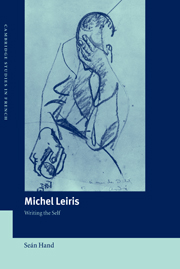Introduction: the deaths of Michel Leiris
Published online by Cambridge University Press: 22 October 2009
Summary
‘Michel Leiris est enfin mort.’ Libération's reaction to Leiris's death at Saint-Hilaire on 30 September 1990, aged 89, may initially have seemed like a cruel valediction, and one emphasizing all the ‘brutality of fact’ that Leiris himself admired in exemplary painters of modern sensibility, such as Picasso and Francis Bacon. The world was evidently not listening to the increasingly muted meditations of a twentieth-century Montaigne: the same issue of the newspaper was taken up mostly with the geopolitics of the post-cold war fallout, applying linguistic analysis to President George Bush's statement to the United Nations about Kuwait, Iraq and the Arab–Israeli conflict, psychoanalysis to the projection and demonization of Saddam Hussain, and something approaching ethnography to the preparations for the opening of ‘Eurodisneyland’. This unconscious and discursively unremarkable use of what had once been revolutionary practice in the hands of Leiris could be read by us as the ultimate compliment and a crowning of his work; more realistically, though, it here betokens his survival into an age of complete mediatization and globalization against which his aesthetic and political endeavours had always struggled, and in which Leiris had perhaps come at the end to represent literally the last of a dying breed.
- Type
- Chapter
- Information
- Michel LeirisWriting the Self, pp. 1 - 12Publisher: Cambridge University PressPrint publication year: 2002
- 1
- Cited by

